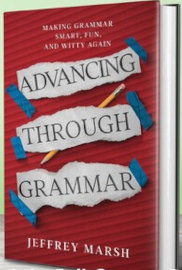Advancing Through Grammar should be great for high school students ready for a deep dive into grammar that's lightened with a humorous delivery. It assumes previous study of grammar and familiarity with the parts of speech, building on that knowledge with in-depth lessons that go beyond the eight parts of speech.
Nouns, verbs, adverbs, and adjectives are taught as “form classes” which make up “99% of the words in the English language” (p. 27). The remaining one percent of words are taught as determiners, auxiliaries, particles, qualifiers, expletives, and interrogatives—called the “structure classes” in this course. Note that "particles" is not a misspelling of participles but describes the combination of a verb with a preposition that together serves as a verb, such as “look up” as used in “They were told not to look up answers online…” (p. 30).
The grammar terms and the approach probably differ somewhat from what students learned previously, but the categories are more comprehensive, and the additional terms help clarify the roles of words in sentences rather than confuse things.
Sentence diagrams are introduced in the third lesson as a tool for analyzing the functions of words. Diagrams are then used throughout the course with increasingly complex sentence structures that illustrate the functions students are learning.
The book has almost 600 pages, and more than 150 of those pages (at the back) serve as an answer key. Each of its 12 chapters has several practice exercises and concludes with a Chapter Wrap Up that lists terms to know and the chapter’s key concepts.
This course is more in-depth than most grammar courses for high school. For example, within the 61 pages of Chapter Four: Demystifying the Verb, the section headings are Verb Forms, The Verb Expansion Rule (help for identifying correct tenses), Deconstructing the Verb, Defining the Verb Tenses, Verb Moods, The Subjunctive Mood, The Passive Voice, Converting Active Voice to Passive Voice, Converting Passive Voice to Active Voice, The Passive Diagrams, Subject-Verb Agreement, E-Prime (a playful connection to calculus where students practice writing without using the eight most common state-of-being verbs), and Puzzles to Ponder (where students learn about midverbs and other oddities). Some students will be overwhelmed by the details, while others will find them intriguing.
Published in 2023, the language of the book reflects the author’s familiarity with today’s teens, as well as with modern technology. For instance, the author writes on page 10:
To grammar purists today—and to all who have passed on to grammar heaven, technology seems to challenge our conventional thinking about effective writing: avoiding run ons and fragments, pressing the shift key and the space bar, cringing at smiley faces anywhere in our writings, especially when we dot our i’s. And we haven’t even touched upon technology’s arcane language of abbreviations: OMG! SMH.
This carries into the practice exercises as well, such as one practice sentence on page 31 that reads, “How pathetic that, of all the heroes, Charlotte chooses to look up to YouTube influencers and Tik Tok celebrities.”
Summary
I found myself reading through quite a bit of the lessons, both because they were entertaining and because they taught elements of grammar with which I wasn’t familiar. Students will not view this course as just another repeat of the grammar they’ve been learning since the elementary grades!









